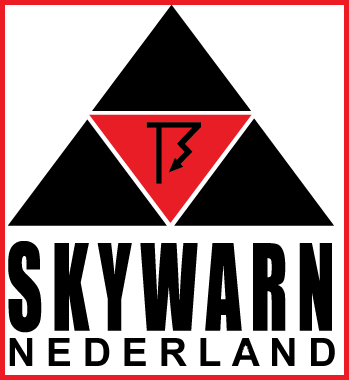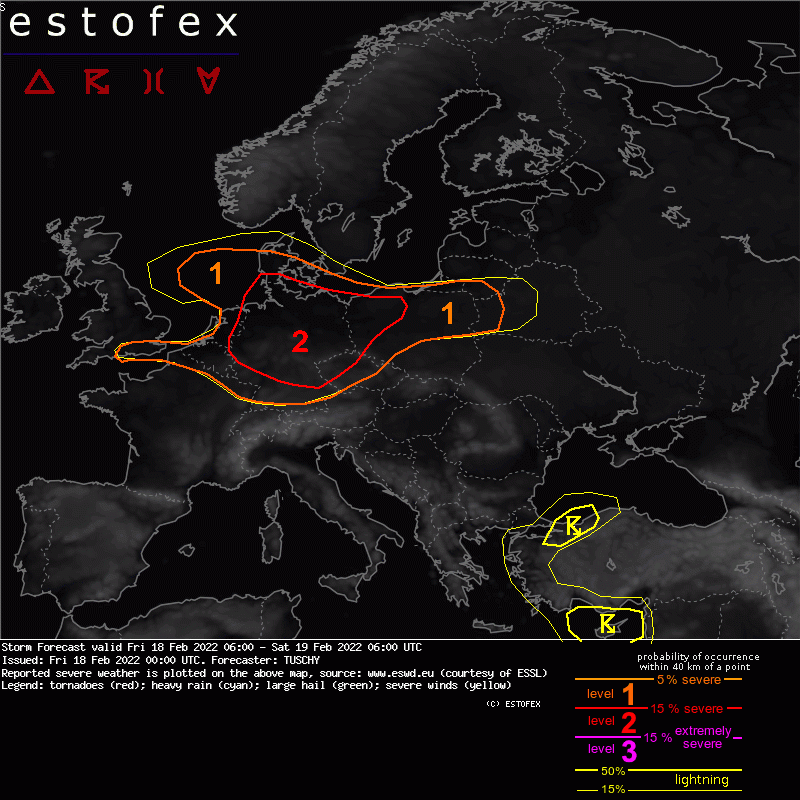
18-02-2022 00:00 | Estofex | m.b.t. 18-02-2022 t/m 19-02-2022

Storm Forecast
Valid: Fri 18 Feb 2022 06:00 to Sat 19 Feb 2022 06:00 UTC
Issued: Fri 18 Feb 2022 00:00
Forecaster: TUSCHY
A level 2 was issued across parts of Benelux into Germany, Poland and Czechia mainly for severe to extremely severe wind gusts. A few tornado events are possible.
The level 2 was surrounded by a level 1 with similar risks but with less coverage.
SYNOPSIS
A dangerous and very dynamic cyclone is ongoing over NW Europe. The main focus will be a deep and highly anomalous depression (regarding its MSLP) just S of Ireland around 06Z, which is about to finish the cross-jet motion towards the pole side of the jet. An intense deepening rate into a Shapiro-Keyser (SK) type cyclone should hence start to level off. Induced impressive irrotational flow into the upper jet weakens the anomalous strong 250 hPa jet- a coupled jet configuration evolves which opens a broad area with extreme upper divergence. However, displaced nature of the upper divergence to this cyclone supports ongoing but more relaxed deepening and also broadening of the depression's core over the North Sea into S Scandinavia during the day. IFS-ENS features rather tight clustering of the center with pressure readings in the 965-970 hPa range over S Norway/Sweden during the forecast. In addition, a second vortex tries to spin up over the S North Sea which races E towards/over Denmark during the night.
Phasing of the trough (which accompanies the deep cyclone) with a progressive ridge over the W into CNTRL Mediterranean keeps an impressive gradient wind alive over CNTRL Europe.
Surface frontal pattern starts SK-ish with dominant frontogenesis along the warm front and a fractured cold front. Betimes the cold front starts to connect back to the warm front while crossing CNTRL Europe to the E.
An amplifying trough over far E Europe induces some convection around the Black Sea/E-Mediterranean with no severe forecast.
DISCUSSION
... CNTRTL Europe ...
Various wind maxima drive havoc during the forecast period:
Ongoing from the previous night a potential sting jet event affects S Ireland into the Celtic Sea with gust regionally well in excess of 150 km/h (mainly offshore/along the coast). No upright convection is forecast although shallow convection (CSI driven) may add some momentum transfer. This event was not highlighted by any level/lightning areas.
During its passage over UK before noon, a broadening and temporarily filling depression sets the stage for an enlarging wind field with a rather intense cold jet (CJ) event. Some NWP discrepancies exist, so a mixture of both jets or even an ongoing sting jet event cannot be ruled out yet. However this change also goes hand in hand with gradually increasing chances for upright convection along the weak/detached cold front, which crosses S-UK from W to E. CAPE will be meager in a strong shear environment (15-20 m/s 0-1 km layer and 25 m/s 0-3 km layer), which raises questions regarding the resistance of those updrafts. Strong to severe wind gusts are possible, but the main CJ remains displaced to the W (same for the postfrontal pressure surge) with weak cross-veer along the front, which should also keep the tornado risk very isolated. Combined with weak convection at that stage we kept this event in a level 1. Beside the limited convective part, (extremely) severe straightline winds are forecast.
Later-on, from Benelux to the E into N-Germany, the CJ spreads rapidly E and overspreads the cold front with impressive readings as H85 winds approach 85 kn. SHR1/3 km increases to 20m/s / 30m/s respectively with even higher values during the afternoon over N-Germany.
The combination of a diurnal driven and advective increase of the LL lapse rates with prefrontal LL mixing ratios around 6 g/kg, increasing LL forcing along the consolidating cold front and LLCAPE in the 50-100 J/kg range plus deepening updrafts all indicate a high chance for effective downward momentum transfer of those wind speeds. Extreme wind gusts are possible with this line of convection (e.g. confined swaths of 33 m/s and more).
Initially the tornado risk seems to be low (e.g. Benelux) but increases slightly as LL mass response of the deepening vortex to the N assists in some backing of the postfrontal flow. More discrete cells evolve along this line over N-CNTRL Germany before weakening thereafter due to outrunning forcing and loss of instability. It is this stage (NW into N-CNTRL Germany), where current expectation are the highest for an isolated tornado risk. Again, further E, weakening is forecast into NE Germany but any convection /shower is able to bring severe wind gusts well into N-Poland during the night. If LL forcing along this CAPE tongue remains stronger than currently forecast, a forced line of broken convection could cross NE Germany into N Poland which is shown by a few models. This would take a low-end tornado and scattered to widespread severe wind gusts risk further E. Given the dynamic nature of this event and (some) NWP tendency to suppress convection too fast, the level areas were extended accordingly.
Further S, better LL convergence along the more active part of the cold front pushes a well structured NCFR E/SE and although wind field weakens somewhat, swaths of 25 m/s gusts are likely before weakening until midnight over Austria/Czechia. Overall ingredients for QLCS tornados seem to be present although current data indicates a rather solid line of convection. Unpredictable mesoscale/orographic influence could still cause an isolated tornado event.
During the afternoon into the overnight hours, non-convective CJ winds affect the S North Sea into the S Baltic Sea. This event is accomapnied by deepening convection, which moves ahore along the German bay. Extreme gusts accompany this activity (although it will be hard to distinguish those gusts from the intense background flow).
Finally, the aforementioned second vortex maximum approaches far S Denmark/extreme N Germany after midnight with a final CJ or sting jet event. This should switch the upright convection back to CSI activity, so convective input should be low with this event. Extreme wind gusts are certainly possible in the 30-40 m/s range. Convection increases thereafter from the NW but with weakening shear.
Overall lightning probabilities remain low (especially in the NWP guidance). However, temporarily strong LL convergence and pockets of EL temperatures around -20C indicate a chance for some electrified activity. With this in mind, we have to add the level areas accordingly.
A confined level 3 was considered over parts of NW into N-CNTRL Germany, but uncertainties regarding the convective activity and LL forcing were still too high for adding.
Onweer/blikseminslag | Tornado/hoosverschijnsel(en) | Verwachtingen/waarschuwingen | Wind/storm (-schade)